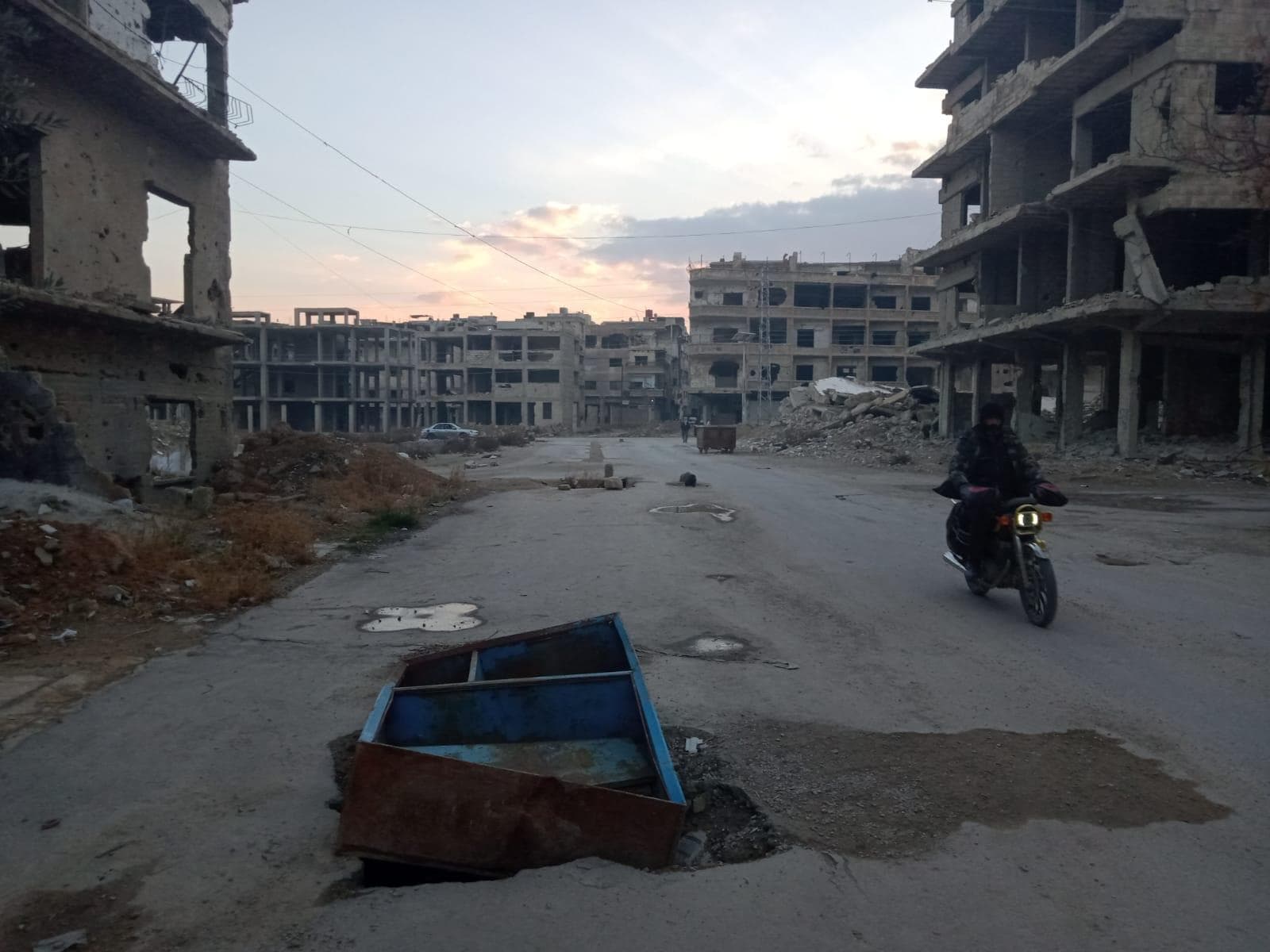A Syrian ghost town

Red Flag’s Omar Hassan, a longstanding supporter of the Syrian revolution and a Palestine solidarity activist, is in Syria to report on the situation after the fall of Bashar al-Assad’s dictatorship. This is the second in his series of reports, the complete list of which can be found in our Syria After Assad section.
--------------------
Standing in the ruins of the Syrian suburb of Harasta is an experience like no other. This was a town of tens of thousands of people, a centre of life and commerce in a region known as Damascus’s breadbasket. It’s now mostly rubble.
Many of the apartment buildings are totally demolished, collapsed in on themselves under the weight of years of bombardment from Syrian and Russian forces. Those that remain standing intact are mere shells—broken concrete facades, all the windows and doors shot out, the steel rods used to strengthen the concrete exposed everywhere. Every block as far as the eye can see is like this, barely standing buildings and mounds of debris and garbage.
Harasta feels like a ghost town, with most buildings emptied of all life. Every now and again you see the odd sign of life, a family that has nowhere else to go. Their determination to go on living evident in their attempt to turn these broken buildings into a home, plugging holes with cardboard and bricks. Passing through this area does something to one’s soul; standing on the shattered streets I feel rage, disbelief and tears welling up in turns.
Yet for those that have been forced to eke out an existence here, the situation is far worse than we can ever imagine. For them, this isn’t simply a landscape of anonymous destruction. It is the place where they grew up, played soccer in the streets, messed about in school. Where they first found love, visited their cousins on weekends, and raised their children. They are living in the ashes of a life and community that has been obliterated and scattered to the four winds. I pity the children growing up in this place, who will think this devastation is somehow normal.
We park the car and approach some locals to talk. They warn us about an unexploded Russian bomb less than two metres from where we stand. “They flattened this whole area”, one man says bitterly, “but some of their bombs didn’t explode. Later, Russians soldiers came through and instead of removing them, they just put up posters warning us not to step there. But these were our homes, and those of our neighbours”. The hatred etched on this man’s face is overwhelming in its purity.
In the distance, we see a few old men picking something from the ground, carrying huge sacks on their back. “Firewood”, explains our driver. “They either use it to stay warm themselves or sell it to buy food.” He doesn’t say more, but his words can’t hide the shame of living in a country where men old enough to be grandparents must do such things to survive.
One of my companions points out that this is what Gaza must feel like. The comparison is apt. Indeed, Assad killed at least 500,000 people, more than Israel has managed. These scenes are replicated around the country, usually in working-class and poor areas.
Harasta itself is just one small part of a wider zone of annihilation that stretches for kilometres around the eastern outskirts of Damascus. These were one of the heartlands of the revolution, a place where mass protests and demonstrations flourished, where rank-and-file soldiers, forcibly conscripted according to the rules of the country, decided that they could not fire on their friends and families, and so mutinied to form a branch of the Free Syrian Army.
It took the government roughly seven years to finally wrest this land from the people who loved and defended it. Some areas were fought over multiple times, with the regime capturing them, only to be driven back again, and so on. Eventually, the government enforced a harsh siege that lasted for almost five years.
By 2016, around 400,000 people were trapped in the area, starved of food and water by Assad’s armies. When that failed, they decided to use chemical weapons, killing 70 people including many children, and sending hundreds more to hospital.
Eventually, a deal was reached in 2018, and well over 100,000 people were shuttled up to Idlib in the buses normally used for public transport. (To this day, some Damascenes boycott these buses in solidarity.) It was a terrible defeat, symbolising a moment that marked the nadir of the heroic struggle to free Syria.
There was no upside to being reincorporated into government-held territory. Reconstruction efforts were banned in the area, a reminder of what happens when you do not accept your position as a slave. Food remained scarce, the infrastructure non-existent.
In one strip, there are huge holes in the road, large enough to fit a car. A local man, who does not wish to identify himself for fear of retribution, explains that the government wanted to redirect the water supply. When they didn’t find what they were looking for, they just moved on and left these cavernous holes in the street. But there are no lights or electricity here, so cars and bikes kept falling in. They found an old bookshelf and used it to cover the hole. “They didn’t care about us”, he says. “They only cared about themselves. So we had to fix the problems.”
He’s hopeful about the future, but cautious. “The new guys seem to be different, treating people with respect”, he says. “Inshallah.”
It’s now dark and freezing cold, so we decide to head back to Damascus. While others chat among themselves, I’m genuinely unable to participate, moved to silence by the sheer barbarity of the capitalist system and those who defend it.
Campfires dot the highway, families huddling close together, trying in vain to keep warm on a terrible winter’s night.